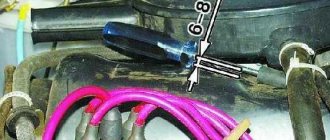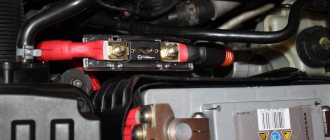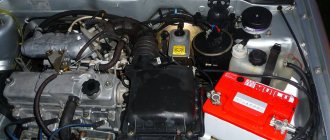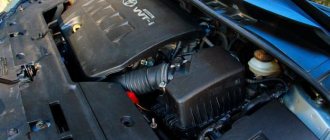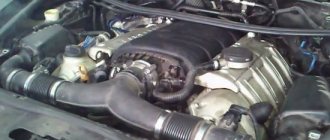What problems may occur
After replacement, owners are faced with various types of malfunctions. Among them:
- the car does not start after replacing the gasket;
- engine troits;
- White smoke comes out of the exhaust pipe;
- While driving, the hydraulic compensators began to knock.
New cylinder head gasket
All these faults indicate some kind of malfunction in the system.
Car won't start
If the engine does not start after replacing the element, there may be various reasons for this.
Repairing and replacing the gasket should be done when you have experience and know how to install the part correctly.
Causes and solutions
If the car does not start, the reasons may be the following:
- The engine does not start due to a defective gasket. You should check its quality, and to do this you need to dismantle the cylinder head again and see if there are any cracks or tears on the gasket. In addition, you must be sure that the sealing element is installed correctly. Often, due to “crooked hands”, car owners encounter similar problems.
- The oil scraper rings should be diagnosed. If they are worn out or show mechanical damage, these components should be replaced immediately. Otherwise, problems with starting the engine will remain.
- It is necessary to check and, if necessary, adjust the compression in the engine cylinders.
- Check the distributor. In practice, sometimes a problem arises when, after changing cylinder head components, the slider wears out. As a result, it is not able to supply the required spark, which makes it impossible to start the engine.
If after performing these steps the engine starts, then finally turn on the ignition. Do this according to the manufacturer's recommendations specified in the service book.
Loading …
Troubles the engine
Trouble the engine - this is a problem that motorists encounter after changing the sealing element of the cylinder head. What to do in such cases?
Causes and solutions
- The motor suffers from a poor-quality gasket or from its incorrect installation. It is necessary to dismantle the gasket and diagnose it visually. If cracks or damage are visible, the component should be replaced.
- Wrong compression level. Sometimes improper compression in the cylinders can cause the engine to trip. The level should be checked and, if necessary, adjusted.
- Failure of hydraulic tensioners. Professionals recommend changing hydraulic tensioners after each disassembly of the cylinder head. Replacing the cylinder head seal is no exception.
- Injectors not working. Experts advise replacing injectors when dismantling the cylinder head and other types of work related to the head. If they were changed, but the internal combustion engine still dies, then perhaps the injectors were defective. Install the old ones in their place and then listen to whether the engine is running or not.
- The ignition or idle speed is not set. This is true for older cars. Sometimes, after dismantling the cylinder head, the idle speed and ignition are disrupted. The problem is solved by adjusting both the ignition and idle speed.
Old and new candles
Hydraulic lifters are knocking
The hydraulic compensators rattled - this malfunction is typical for vehicles on which the cylinder head was dismantled.
Causes and solutions
- If the hydraulic compensators knock during startup, the cause may be engine fluid leaking from part of one of the elements. This problem arises after replacing the cylinder head gasket and leaving the vehicle unused for a long time. Usually this problem goes away on its own.
- If the hydraulic compensators rattle when the car warms up, but the noise disappears when the speed increases, this may indicate damage or wear to the check valve ball. In this case, the hydraulic compensator should be replaced. This may indicate that the device is contaminated with all kinds of wear products. Then you will need to clean the device and replace the engine fluid.
- If the hydraulic compensators knock when hot, but there is no such problem when operating on a cold engine, this may indicate a leak of engine fluid through large gaps between the plunger and the mechanism sleeve. The complete device needs to be replaced.
Hydraulic compensator disassembled - Sometimes it happens that hydraulic compensators make a knocking sound at high speeds, but there is no knocking at low speeds. This indicates foaming of the engine fluid or air being sucked in by the pump when the fluid level in the crankcase is too low. In both cases, the level of consumables should be brought to normal. However, this may indicate mechanical damage to the oil receiver, which appears as a result of external influences, for example, after hitting a road obstacle. In this case, the defective parts must be replaced. As a rule, after such actions the knocking problem disappears.
- Also, a knocking sound may indicate a gap between the cam and the camshaft pulley pusher. The gap occurs as a result of mechanical damage or contamination of the hydraulic compensator elements. To solve the problem, remove the cylinder head cover, and then install all the cams of the timing pulley up one by one. When the cams are installed, you need to check for clearance between the cams and the tappets.
- Then you will need to recess the pusher, while simultaneously comparing the speed at which it moves with the speed of movement of other hydraulic pushers. If during movement there is a small gap or the movement speed is increased, then the hydraulic compensator should be disassembled. All its components should be cleaned of carbon deposits and other contaminants. If you see that it is difficult to clean a component and the result is unsatisfactory, then it is better to replace the component.
White smoke coming from the exhaust
White smoke from muffler
White smoke from the exhaust pipe is a fairly common problem that appears after dismantling the cylinder head. To understand how to get rid of this malfunction, you need to determine the reasons why white smoke may be coming from the muffler.
- If thick white smoke comes out of the muffler after the engine warms up, and the smoke has a high density, as evidenced by a huge cloud, then this indicates significant malfunctions. In practice, white smoke occurs when antifreeze enters the engine. Cooling consumables enter the engine when the seals designed to prevent antifreeze from entering the cylinder wear out. This may also indicate a worn cylinder head gasket.
- Cracks in the cylinder head are also the cause of thick smoke coming from the exhaust pipe. It is better to entrust such repair work to professionals, since cracks can only be removed by welding. If the crack is large, then to get rid of the smoke, you will have to completely replace the block head.
- If you are the owner of an old vehicle that is equipped with a valve with a vacuum hose for the engine, then the appearance of smoke may be a consequence of leaking transmission oil. And the transmission fluid flows directly through this valve. This consumable quickly contaminates the spark plugs, resulting in the failure of one of the cylinders. To get rid of smoke, you should check the valve and replace it.
Car won't start after replacing cylinder head gasket? List of possible causes
It often happens that after replacing the cylinder head gasket the car does not start. As a rule, the reason is incorrect assembly. Unfortunately, many novice mechanics make mistakes during assembly. For the most part, the shortcomings during repairs are the same for everyone. However, some of the mistakes can lead to very serious consequences. Up to a major overhaul of the entire engine. Therefore, it is important to assemble correctly right away. This will save you from many problems in the future.
Study all the features of installing the cylinder head, and also become familiar with the correct engine tuning. It is advisable to consult with experienced mechanics; they can tell you how to do certain jobs correctly.
Engine won't start after replacing cylinder head gasket
VAZ 21083 injector, after replacing the cylinder head gasket the engine does not start, the timing belt has set everything to perfection, but it can’t. VAZ 2110 does not start after replacing the cylinder head gasket.
Similar articles
14 comments on “The VAZ 2110 does not start after replacing the cylinder head gasket. After replacing the cylinder head gasket, the engine does not start”
So it's not ideal!
Has the key on the lower pulley fallen out? She falls out. She has something like this.
Look, the sensors are all connected
Look at the marks on the engine and on the camshaft. See the spark. Crankshaft sensor.
All marks are perfect, flywheel is as marked, camshaft is as mark as, crankshaft is as mark as everything, spark like lightning, sensor is normal
Compression has nothing to do with it. If the labels are normal. All sensors are connected. There is a spark, fuel is spraying. Then it's mysticism
Check the compression. There are no miracles. Check spark, fuel.
1. If there is a spark, there is fuel and it splashes into the pots, the marks are normal, then all that remains is to drive the car to church. Measure the compression for peace of mind, turn off the immobilizer (there was a case when it was disabled by software, but it interfered with the start-up) or the signaling system is blocking the injection. There are no options - there is a spark, there is fuel, there is compression at the normal level - it will start. The last resort is to reset the ECU...
He realized that somewhere a simpler calculation had been made, the thread had been broken and the only way to finish the calculation was to add the numbers again. Lewis Carroll.
I can even hear the fuel pump running, I filled the tank, I even sprayed a little gasoline into the cylinders, but when you turn it on, you hear that it turns on as if it’s late and the starter is smoking, damn it, it’s hard to turn it, I even installed an Akum from another car that’s 100% charged to make sure everything is ok
Has the car been parked for a long time? Perhaps the piston was stagnant, I had this happen, I poured hot water behind the antifreeze and the current started up a lot with the starter, don’t turn it around, who can burn out since it’s hot already take breaks and check the spark plugs, they may be in gasoline, if so, wipe dry..
Car won't start after replacing cylinder head gasket? List of possible causes
It often happens that after replacing the cylinder head gasket the car does not start. As a rule, the reason is incorrect assembly. Unfortunately, many novice mechanics make mistakes during assembly. For the most part, the shortcomings during repairs are the same for everyone. However, some of the mistakes can lead to very serious consequences. Up to a major overhaul of the entire engine. Therefore, it is important to assemble correctly right away. This will save you from many problems in the future.
Study all the features of installing the cylinder head, and also become familiar with the correct engine tuning. It is advisable to consult with experienced mechanics; they can tell you how to do certain jobs correctly.
Car won't start after replacing cylinder head gasket?
This often happens due to broken timing marks. Some mechanics do not carefully mark the position of the pulleys when removing the head. The timing belt is also often installed very carelessly. But even a slight displacement of the marks leads to a malfunction of the engine. In this case, the compression stroke occurs in one cylinder, and the spark discharge occurs in the other.
To avoid such a problem, before disassembling the engine, be sure to draw out the marks so that they completely match. When installing the head back and assembling the timing drive, be sure to check the complete alignment of the marks. On some models there are additional marks on the flywheel. You can’t forget about them either.
If you made a mistake with setting the marks, then after setting them correctly, you can expect another trouble, which often accompanies a failure of the valve timing. We are talking about bent valves. Therefore, if, after returning the timing marks to their normal position, the car still refuses to start, you will have to remove the head and check the condition of the valves. They often end up bent. The fact is that when the phases shift, the risk of the piston meeting the valve increases many times over. By cranking the engine with the starter, you can literally destroy all the valves in one go.
If you have such a problem, you will have to completely replace the valve. At the same time, do not forget to rub them in. After grinding, be sure to rinse the parts and dry them. If lapping paste remains on the valve, this can lead to increased piston wear and cylinder damage.
If your car started up after replacing the gasket, but after a short period of work it stalled and refused to start. Check the condition of the oil. If there is white foam in it, this means the gasket is burnt or damaged. This can happen due to weak tightening of the cylinder head mounting bolts or an incorrect sequence of performing this work. Operating the engine in this condition is prohibited. Be sure to take steps to correct the problem.
It will be useful: Repair and replacement of the starter bendix (overrunning clutch): what is it, how to check the part and the drive of the unit
To do this you will have to remove the block head. When examining the gasket, it turns out that it is damaged. You need to remove it and thoroughly clean the surface of the block and cylinder head. Remains of an old gasket can also lead to a similar problem. When assembling, pay attention to the correct tightening of the bolts. This should be done from the middle to the edges. Thus, there is no deformation of the cylinder head, and the process is as efficient as possible. Tightening should be done with a certain torque; for this it is best to use a torque wrench. After assembly, do not forget to change the engine oil. You also need to replace the antifreeze.
On carburetor engines there may be a problem. When removing and installing a cylinder head, even experienced craftsmen may encounter such problems. Of all the engine starting problems after changing the cylinder head gasket, this is the most easily solved. In this case, consider what ignition system is used in your car.
Carrying out repair work related to the cylinder head requires special care and precision. Since one wrong action can have a detrimental effect on the functioning of the motor as a whole. Therefore, domestic car owners often encounter a problem when, after replacing the cylinder head gasket, the car does not start. What to do in such cases?
Timing marks
Car won't start after replacing cylinder head gasket? This often happens due to broken timing marks. Some mechanics do not carefully mark the position of the pulleys when removing the head. The timing belt is also often installed very carelessly. But even a slight displacement of the marks leads to a malfunction of the engine. In this case, the compression stroke occurs in one cylinder, and the spark discharge occurs in the other.
To avoid such a problem, before disassembling the engine, be sure to draw out the marks so that they completely match. When installing the head back and assembling the timing drive, be sure to check the complete alignment of the marks. On some models there are additional marks on the flywheel. You can’t forget about them either.
If you made a mistake with setting the marks, then after setting them correctly, you can expect another trouble, which often accompanies a failure of the valve timing. We are talking about bent valves. Therefore, if, after returning the timing marks to their normal position, the car still refuses to start, you will have to remove the head and check the condition of the valves. They often end up bent. The fact is that when the phases shift, the risk of the piston meeting the valve increases many times over. By cranking the engine with the starter, you can literally destroy all the valves in one go.
If you have such a problem, you will have to completely replace the valve. At the same time, do not forget to rub them in. After grinding, be sure to rinse the parts and dry them. If lapping paste remains on the valve, this can lead to increased piston wear and cylinder damage.
How to replace a cylinder head gasket with your own hands
It is best to carry out measures to replace a non-working sealing element in a garage or under a canopy, to prevent unintentional entry of moisture and dust into the engine cylinders. You should purchase a gasket in advance, focusing on the car model, year of manufacture and engine characteristics (gasoline, diesel). The standard set of tools must be supplemented with a torque wrench to accurately comply with the recommended forces when tightening the engine head fastening elements.
Step-by-step instructions for replacing the cylinder head gasket
Different car models have a standard assembly part layout, and therefore the cylinder head gasket is replaced in most of them, following the following sequence;
- Preparation. The car is placed on a level surface. Turn off the power from the battery, drain the coolant, and “relieve” the fuel system pressure.
- Dismantling of attachments. Loosen the fastening clamps, disconnect the contact groups of wires, and remove the pipes. Disable the control drives of the fuel system, where the volume of work is determined by the gasoline or diesel engine. Remove the timing belt.
- Removing the head. Having gained full access to the unit being dismantled, unscrew the fastening bolts and remove them along with the washers. Using sufficient force, remove the head on which the gasket is placed.
- Preparing the seat. This stage requires a responsible attitude. It is necessary to remove carbon deposits, dirt, small metal shavings, etc. At the same time, the condition of the valves, cylinder bores and the external condition of the piston group is assessed.
- Installation and assembly. The consumables are installed in compliance with all the features of the seat. Tightening of fasteners is carried out sequentially in compliance with the tightening torque. This indicator varies for different models, but re-pulling is required after 1 - 2 thousand kilometers.
Further work involves installing attachments in their standard places, with mandatory verification of correct installation. Pour in technical fluids and visually evaluate the result with the engine running.
Key points when replacing the cylinder head gasket
When performing work, you must pay attention to the following recommendations:
- errors during assembly will be eliminated by arranging the parts to be removed in sequential order;
- pre-treatment of fastening elements with special compounds will remove dirt and prevent the destruction of edges under extreme loads when unscrewing them;
- they begin to loosen the head bolts from the middle part - the adhesion tension of the surfaces is relieved, the overall load is reduced;
- the head fastening must be tightened with a torque wrench with precise adherence to the torque;
- As the units are assembled, they carry out maintenance of all dismantled parts and devices, including detachable wiring connections.
Replacing the cylinder head gasket on a domestic car is presented in the following video:
How to install
The cylinder head is placed on top of the engine cylinder block. It is fastened with long bolts or threaded rods. Since the seating area is large, the order of tightening the bolts is observed during installation. This will eliminate structural deformation and possible breakdowns, as well as gas breakthrough.
Note that on in-line power units the cylinder head covers the entire block. And on V-shaped engines, each row has its own head. But regardless of the type of cylinder block layout, a reinforced gasket is installed between the head and it. What is a cylinder head gasket in a car? This is a sealing element. The gasket is made of a hard, fire-resistant material that prevents the coolant from mixing with exhaust gases and oil. This part is installed on all internal combustion engines. The only exceptions are some sports internal combustion engines. Here the head is ground so evenly and smoothly that its contours completely coincide with the cylinder block.
If the car won't start...
If you replaced a worn cylinder head gasket and immediately started having problems starting the engine, the reasons are as follows:
- The gasket itself turned out to be defective. You will have to dismantle it and carefully check for breaks or cracks.
- The gasket is not installed correctly. Double-check the quality of the seal assembly.
- Oil scraper rings are worn out. Needs to be replaced.
- The compression in the cylinders is not adjusted. It should be checked with a compression gauge (the difference in the cylinders should be no more than 10%).
- The runner (distributor) is worn out. Due to the breakdown, there is no spark and the internal combustion engine does not start. The distributor needs to be replaced.
After checking and debugging the listed components, you must once again set the ignition in accordance with the recommendations of the manufacturer of your car.
Gasket problem
If your car started up after replacing the gasket, but after a short period of work it stalled and refused to start. Check the condition of the oil. If there is white foam in it, this means the gasket is burnt or damaged. This can happen due to weak tightening of the cylinder head mounting bolts or an incorrect sequence of performing this work. Operating the engine in this condition is prohibited. Be sure to take steps to correct the problem.
To do this you will have to remove the block head. When examining the gasket, it turns out that it is damaged. You need to remove it and thoroughly clean the surface of the block and cylinder head. Remains of an old gasket can also lead to a similar problem. When assembling, pay attention to the correct tightening of the bolts. This should be done from the middle to the edges. Thus, there is no deformation of the cylinder head, and the process is as efficient as possible. Tightening should be done with a certain torque; for this it is best to use a torque wrench. After assembly, do not forget to change the engine oil and flush the engine at the same time. You also need to replace the antifreeze.
How to find out if the cylinder head gasket is blown
You can determine whether the cylinder head gasket is blown by using one of several methods. In this case, diagnostics are simple and can be done by anyone, even a novice and inexperienced driver.
To check the integrity of the gasket, you must do one of the following:
- With the engine running, visually inspect whether smoke is coming from the gap between the cylinder head and the cylinder head . Also listen to see if there are loud ringing sounds coming from there that were not there before.
- Inspect the surfaces of the radiator caps and expansion tank of the cooling system, as well as the neck for filling oil into the engine. To do this, you just need to unscrew them and visually inspect them. If antifreeze gets into the engine, there will be a reddish emulsion on the oil filler cap. If oil gets into the antifreeze, then there will be oily deposits on the radiator or expansion tank caps.
White smoke from the exhaust pipe
How to check a cylinder head gasket using a condom
One of the effective and popular testing methods is the method using a balloon or a condom. It is put on the neck of the expansion tank, having first unscrewed the cap. The main thing is that the condom sits tightly on the neck and provides a tight seal (instead of a condom, you can use a bag or a balloon, but the diameter of the condom is usually ideal for the neck of the tank). After you put it on the reservoir, you need to start the engine and let it run for a few minutes at 3.5 thousand rpm. Depending on the level of depressurization, the condom will fill with gases quickly or slowly. It depends on the specific situation. In any case, if it begins to fill with exhaust gases, this means that the cylinder head gasket is broken.
Checking the cylinder head gasket with a condom
Checking the gasket with a bottle
Another method for determining whether the cylinder head gasket is broken is often used on trucks . To do this, it is enough to have a small bottle of water (for example, 0.5 liters). As a rule, expansion tanks have a breather (a tube that helps maintain the same pressure as atmospheric pressure in a closed container). The method is very simple. With the engine running, place the end of the breather in a container of water. If the gasket is broken, air bubbles will begin to come out of the tube. If they are not there, then everything is in order with the gasket. If at the same time coolant begins to appear from the breather, this also means that everything is in order with the gasket.
Signs of a broken cylinder head gasket
Prerequisites for checking the condition of the gasket are presented:
- traces of engine oil or antifreeze are visible on the perimeter of the junction of the head and the engine base;
- when checking the oil, there is a light foamy coating on the dipstick, indicating that cooling liquid has entered the crankcase;
- light thick smoke from the exhaust pipe, after warming up the internal combustion engine, also informs about the presence of antifreeze in the crankcase;
- grease stains in the cooling expansion tank or radiator indicate oil leakage into the cooling system.
Important! If, during inspection, one or more signs are identified, it is necessary to take measures to identify the causes, and possibly replace the gasket. Otherwise, the consequences will entail a major overhaul of the engine.
What does a breakdown in the cylinder head gasket lead to?
Operation of a vehicle with a damaged sealing element is presented as follows:
- the car will have difficulty starting, and during operation it may smoke and traction will deteriorate;
- the engine will stall during operation, and its speed will be unstable;
- compression may be lost in the cylinders;
- If the engine oil is diluted with antifreeze, the internal parts will “grind” each other.
As a result, a visit to a service station is guaranteed to replace parts and assemblies that have fallen out of working order.
What to do if the car does not start after replacing the cylinder head gasket?
Carrying out repair work related to the cylinder head requires special care and precision. Since one wrong action can have a detrimental effect on the functioning of the motor as a whole. Therefore, domestic car owners often encounter a problem when, after replacing the cylinder head gasket, the car does not start. What to do in such cases?
The car stopped starting after replacing the cylinder head gasket
The cylinder head gasket (cylinder head) is an important element in the assembled engine, the integrity and correct installation of which determines the safety of the engine. Therefore, when, after replacing the gasket, the car suddenly starts to start poorly or does not start at all, many car owners begin to panic.
In fact, you are dealing with a fairly simple malfunction that can be fixed on your own. But this needs to be done correctly and quickly in order to eliminate the risk of more complex internal combustion engine breakdowns.

